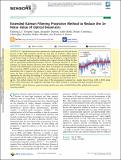Files in this item
Extended Kalman filtering projection method to reduce the 3σ noise value of optical biosensors
Item metadata
| dc.contributor.author | Li, Kezheng | |
| dc.contributor.author | Gupta, Roopam | |
| dc.contributor.author | Drayton, Alexander | |
| dc.contributor.author | Barth, Isabel | |
| dc.contributor.author | Conteduca, Donato | |
| dc.contributor.author | Reardon, Christopher | |
| dc.contributor.author | Dholakia, Kishan | |
| dc.contributor.author | Krauss, Thomas F. | |
| dc.date.accessioned | 2020-12-07T15:58:30Z | |
| dc.date.available | 2020-12-07T15:58:30Z | |
| dc.date.issued | 2020-11-25 | |
| dc.identifier | 271317730 | |
| dc.identifier | d1e6ef02-4c0d-403d-8255-c0eced878c3d | |
| dc.identifier | 85095868868 | |
| dc.identifier | 000595550100018 | |
| dc.identifier.citation | Li , K , Gupta , R , Drayton , A , Barth , I , Conteduca , D , Reardon , C , Dholakia , K & Krauss , T F 2020 , ' Extended Kalman filtering projection method to reduce the 3σ noise value of optical biosensors ' , ACS Sensors , vol. 5 , no. 11 , pp. 3474–3482 . https://doi.org/10.1021/acssensors.0c01484 | en |
| dc.identifier.issn | 2379-3694 | |
| dc.identifier.other | RIS: urn:C54AD9F5F04719A351E7D2BCF80B7FAF | |
| dc.identifier.other | ORCID: /0000-0002-3267-9009/work/83889973 | |
| dc.identifier.uri | https://hdl.handle.net/10023/21098 | |
| dc.description | The work was financially supported by the Engineering and Physical Sciences Research Council of the UK through grants EP/P02324X/1 (“MAPS”) and EP/ P030017/1 (“Resonant Photonics”). T.F.K. also acknowledges support through a Royal Society Wolfson fellowship. | en |
| dc.description.abstract | Optical biosensors have experienced a rapid growth over the past decade because of their high sensitivity and the fact that they are label-free. Many optical biosensors rely on tracking the change in a resonance signal or an interference pattern caused by the change in refractive index that occurs upon binding to a target biomarker. The most commonly used method for tracking such a signal is based on fitting the data with an appropriate mathematical function, such as a harmonic function or a Fano, Gaussian, or Lorentz function. However, these functions have limited fitting efficiency because of the deformation of data from noise. Here, we introduce an extended Kalman filter projection (EKFP) method to address the problem of resonance tracking and demonstrate that it improves the tolerance to noise, reduces the 3σ noise value, and lowers the limit of detection (LOD). We utilize the method to process the data of experiments for detecting the binding of C-reactive protein in a urine matrix with a chirped guided mode resonance sensor and are able to improve the LOD from 10 to 1 pg/mL. Our method reduces the 3σ noise value of this measurement compared to a simple Fano fit from 1.303 to 0.015 pixels. These results demonstrate the significant advantage of the EKFP method to resolving noisy data of optical biosensors. | |
| dc.format.extent | 9 | |
| dc.format.extent | 3403569 | |
| dc.language.iso | eng | |
| dc.relation.ispartof | ACS Sensors | en |
| dc.subject | Optical biosensors | en |
| dc.subject | Signal processing | en |
| dc.subject | Signal-to-noise ration | en |
| dc.subject | Extended Kalman filter | en |
| dc.subject | Guided mode resonance | en |
| dc.subject | Microring resonator | en |
| dc.subject | QD Chemistry | en |
| dc.subject | T-NDAS | en |
| dc.subject.lcc | QD | en |
| dc.title | Extended Kalman filtering projection method to reduce the 3σ noise value of optical biosensors | en |
| dc.type | Journal article | en |
| dc.contributor.sponsor | EPSRC | en |
| dc.contributor.institution | University of St Andrews. School of Medicine | en |
| dc.contributor.institution | University of St Andrews. Cellular Medicine Division | en |
| dc.contributor.institution | University of St Andrews. School of Physics and Astronomy | en |
| dc.contributor.institution | University of St Andrews. Sir James Mackenzie Institute for Early Diagnosis | en |
| dc.contributor.institution | University of St Andrews. Centre for Biophotonics | en |
| dc.contributor.institution | University of St Andrews. Biomedical Sciences Research Complex | en |
| dc.identifier.doi | 10.1021/acssensors.0c01484 | |
| dc.description.status | Peer reviewed | en |
| dc.identifier.grantnumber | EP/P030017/1 | en |
This item appears in the following Collection(s)
Items in the St Andrews Research Repository are protected by copyright, with all rights reserved, unless otherwise indicated.

